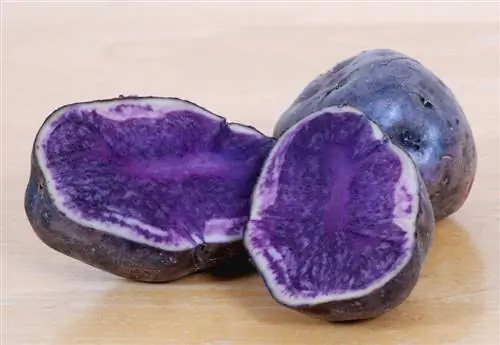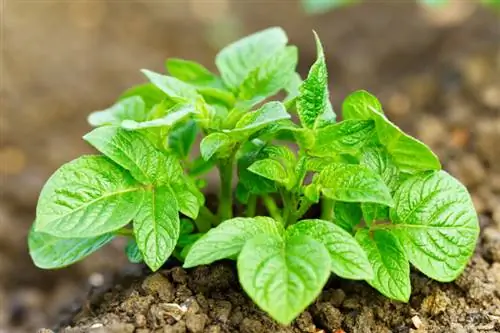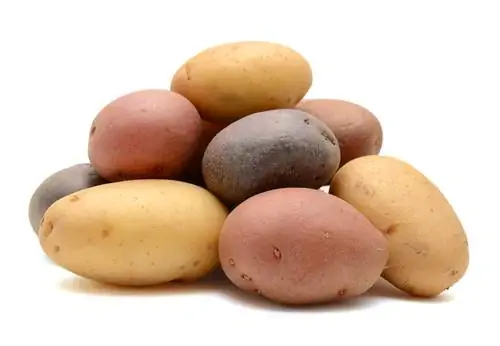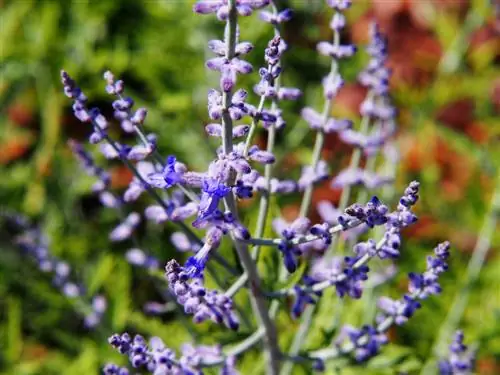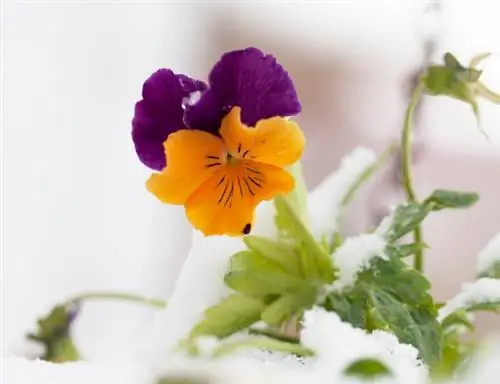- Author admin [email protected].
- Public 2023-12-16 16:46.
- Last modified 2025-06-01 06:02.
Blue potatoes are on everyone's lips. The lively tubers add color to the plate and the bed. Which variety should it be? Get to know 10 premium varieties here with tips on important properties, optimal preparation and profitable cultivation in the hobby garden.

What are popular blue potato varieties and their benefits?
Blue potatoes are characterized by their special coloring, which is due to the anthocyanin content. The best-known varieties include Vitelotte, Blauer Schwede, Blaue Anneliese, Blaue Sankt Galler and Purple Rain. They are he alth-promoting, rich in nutrients and offer variety in taste.
- Top varieties with blue skin and blue flesh are Vitelotte, Blauer Schwede, Blaue Anneliese, Blaue Sankt Galler and Purple Rain.
- Premium varieties with blue skin and light flesh include Odenwälder Blaue, Sarpo Blue Danube, Shetland Black, Arran Victory and Black Ungarin.
- The best time to plant blue seed potatoes is in April in a sunny location in fresh, moist, humus-rich, nutrient-rich soil. The more eyes the seed, the higher the yield of blue potatoes.
Blue potatoes - 5 top varieties - blue skin, blue flesh
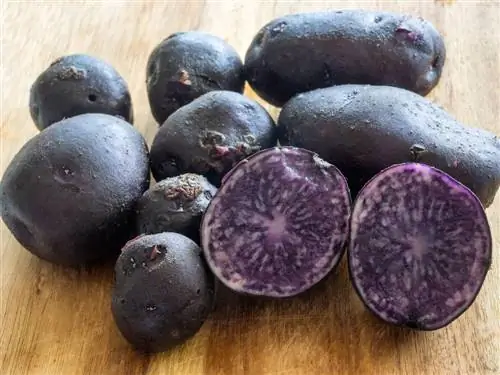
Some potato varieties are blue both inside and outside
We invite you to take a stroll through the colorful world of spectacular blue potatoes. Get to know 5 top varieties that delight with blue skin and blue flesh:
| Premium varieties (blue/blue) | Vitelotte | Blue Swede | Blue Anneliese | Blue Saint Galler | Purple Rain |
|---|---|---|---|---|---|
| Cooking feature | boiling | flourycooking | boiling | predominantly waxy | boiling |
| Maturation period | late | mid-early | mid-late to late | mid-early | mid-early |
| Flesh color | violet-blue | violet, white spotted | dark blue | blue to violet | violet blue/white marbled |
| Color shell | dark blue | violet with silver scab | blue-black | dark blue | blue-black |
| Origin | France | Sweden | Lüneburg Heath | Switzerland | Netherlands |

Is your mouth already watering at the sight of our blue potato favorites? Then read on. In the following sections, we subject each top variety to a Lucullus check with practical tips for optimal preparation.
Vitelotte
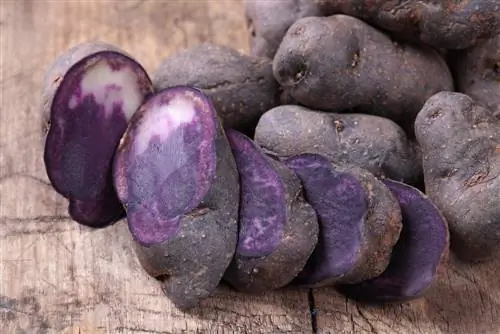
Vitelotte is probably the most famous blue potato variety
Vitelotte is probably the most famous blue potato variety in Germany. French star chefs have aptly named the sapphire among potatoes the truffle potato. In fact, the exquisite taste is reminiscent of truffles and mildly spicy chestnuts. The potato-like delicacy is highly recommended as:
- Jacket potatoes with melted cheese
- thinly sliced and fried as potato carpaccio
- Potato salad (colorfully mixed with light and red potatoes)
Blue Swede
The legendary variety from Scandinavia takes 130 to 150 days to ripen. When cooked, the flesh of the fruit changes color from purple to blue. Blauer Swede scores with excellent food value and is also known under the trade names Blue Congo and Idaho Blue. Gourmets recommend not boiling these blue potatoes, but rather gently steaming them or baking them in the oven. Blue Swede is primarily suitable:
- as jacket potatoes
- for mashed potatoes
- as a baked potato
Blue Anneliese
The tasty Blue Anneliese celebrated its premiere on the market in 2004. Since then, the gourmet hobby gardeners have succumbed to the fine blue potato and buy all the supplies of seed potatoes for their own cultivation every season. Our extra tip: If you would like to grow the Blue Anneliese yourself, reserve the seeds in good time with your trusted provider. The blue potato is ideally prepared:
- as boiled potatoes
- as jacket potatoes with quark
- as baked potatoes with crème fraîche
Blue Saint Galler
Christoph Gämperli from Flawil worked for a long 15 years until he was able to present his new breed in 2004. The result can be seen and tasted. Blue Sankt Gallen impresses in terms of color, taste, texture and appearance. Thanks to its at least semi-solid consistency, this premium variety is ideal as:
- Boiled potatoes
- Salad potatoes
- Baked potatoes
In the following video, the breeder has his say with interesting information about the Blue Saint Galler:

Purple Rain
The new breed from 2019 impresses with its waxy, purple-white marbled flesh. The blue potato is characterized by very good taste and a long shelf life. The color remains during cooking even if you peel the tubers. Recommended preparations are:
- Boiled potatoes
- fried potatoes
- Potato Salad
Excursus
Blue potatoes are he althy
Blue potatoes owe their beautiful blue color to valuable secondary ingredients, the anthocyanins. These bioflavoids are primarily found in blue, purple and red food plants and are useful as natural antioxidants. Scientists found that the blue natural dye lowers blood pressure, strengthens circulation, protects cells and has an anti-inflammatory effect. If blue potatoes are regularly served on the table, the he alth and well-being of the whole family benefit from the colorful treat.
5 top varieties - blue skin, yellow flesh
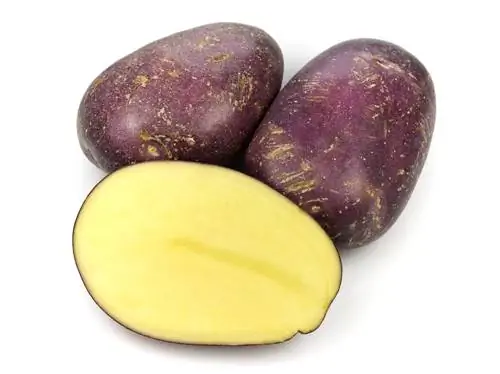
Other types of potatoes only have a blue skin but are yellow inside
Do you have a penchant for color experiments on your plate, but not in the mood for culinary adventures? Then the following blue potatoes are just the thing to grow and enjoy yourself. These 5 top varieties impress with their blue skin and classic yellow flesh:
| Premium varieties (blue/yellow) | Odenwälder Blaue | Sarpo Blue Danube | Shetland Black | Arran Victory | Black Hungarian |
|---|---|---|---|---|---|
| Cooking feature | floury | predominantly waxy | predominantly waxy | floury | floury |
| Maturation period | mid-early | early maturing | mid-early | very late | mid-early |
| Flesh color | light yellow | white | white with purple ring | light yellow to whitish | light yellow to white |
| Color shell | violet-blue | blue-red | blue-black | dark blue-violet | dark blue, almost black |
| Origin | Germany | Wales | Great Britain | Scotland | Hungary |
The following Lukullus check sums up why it is worth growing and eating the premium varieties on this list yourself with tips for ideal preparation.
Odenwälder Blaue
The historic variety from 1908 pampers the palate with a spicy taste. A particular advantage is robust resistance to viral diseases. Furthermore, the seeds produce the best yields even when the soil is slightly moister, as long as there is no waterlogging. Recommended preparations are:
- Mashed potatoes
- Boiled potato
- Baked potato
Sarpo Blue Danube
Many blue potatoes can impress with the best taste and star quality. Sarpo Blue Danube also shines as a feast for the eyes in the bed with purple-black stems, dark, shiny leaves and magnificent, blue bowls. The predominantly firm, white flesh tastes delicious like this:
- in potato salad
- as fried potatoes
- as a baked potato
Shetland Black
It is a remarkable blue potato that you harvest after 130 to 150 days of maturity. There is very light flesh under the blue-black skin. If you don't peel the gem, the blue dye will pass into the flesh during cooking and create a delicate purple inner ring. Thanks to its creamy consistency, we recommend preparing it as:
- Salad
- jacket potato
- puree
Arran Victory
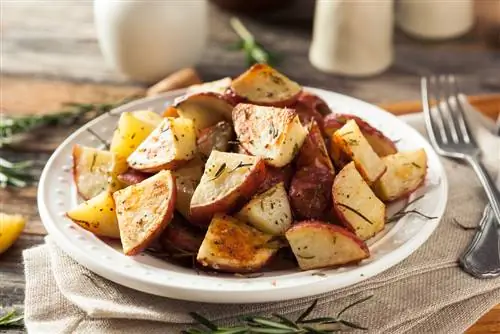
Blue roasted potatoes are a special culinary experience
Up to 170 days of ripening will take place before you can harvest these blue potatoes. The wait is worth it. Since the beginning of the 20th century, Arran Victory has brought gardeners rich yields and is resistant to the dreaded late blight. Given the fine, floury, flaky potato taste, this blue potato is best served like this:
- as tender mashed potatoes
- as spicy roasted potatoes
- as a delicious potato gratin with cheese gratin
Black Hungarian
The historic local variety from Hungary is used to suffering when it comes to location conditions. Even if the light supply and soil quality leave something to be desired, this robust blue potato variety delivers considerable yields. The floury, creamy pulp can be easily processed into:
- Dumplings
- puree
- Potato soup
Tip
Blue potatoes with green spots on the skin are not ripe. The green color signals an increased level of toxic solanine, which in large quantities causes nausea and stomach problems. By peeling the blue tubers, you reduce the solanine they contain. Large green potatoes from the blue variety category are not suitable for consumption.
Growing blue potatoes - tips for hobby gardeners

Potato variety in the garden brings a variety of flavors to the plate
Blue potatoes only stand out in terms of color. When grown in the vegetable patch, the colorful tubers do not differ from traditional, bright varieties. The following tips summarize when to plant blue potatoes, which location the great tubers prefer and what to pay attention to when growing them:
- Planting time: early to mid-early varieties from the beginning of April, later maturing varieties from mid/end of April
- Seed quality: Plant seed potatoes with as many eyes as possible
- Location: sunny and warm
- Soil: nutrient-rich, loose humus, fresh and moist, pH value around 6.5
- Planting distance in row: 30 to 40 cm
- Row spacing: 50 to 60 cm (late varieties 65 to 70 cm)
- piling up: from a height of 15 cm and in case of risk of late frost
If you prepare the bed in the fall of the previous year, blue potato varieties will give you a particularly rich harvest. To do this, rake the soil vigorously and incorporate 5 liters of mature compost per square meter.
Frequently asked questions
Are blue potatoes also he althy during pregnancy?
Blue potatoes have an extra portion of valuable nutrients and he althy organic flavoids in their luggage. Scientists and nutrition experts confirm that regular consumption strengthens circulation, regulates high blood pressure, mobilizes the immune system and prevents obesity. Expectant mothers particularly benefit from these properties during pregnancy.
Potatoes have bruises on the skin. What to do?
Potatoes, like people, react to violent impacts with bruises. The tubers often develop these shock marks on the long journey from harvest to the store shelf. There is no cause for concern. Bruises on potatoes do not affect the taste and are not harmful to he alth. When cooked, the blue areas turn black or brown, which doesn't look particularly appetizing. To counteract this, you can peel the potatoes and cut out the discoloration.
Can you eat blue potatoes with skin on?
If you grow blue potatoes yourself or buy them in an organic store, you can safely eat the tubers with the skin on. If you cook blue potatoes with the skin on, the rich color of the flesh is better preserved. To prepare them as fries, cut the unpeeled blue potatoes into the right shape and enjoy the spicy blue sticks with the peel on.
Tip
Creative hobby chefs conjure up a colorful potato festival on the table. The culinary stroke of genius is achieved with a mix of blue and red potato varieties. Delicious red potatoes include 'Heiderot', a tender early potato, 'rote Emmalie', a waxy delicacy and 'Red Cardinal', a historic noble variety from 1902.

